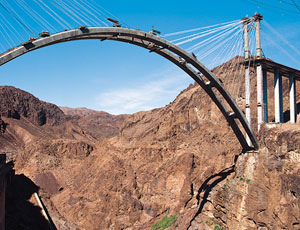A funding delay, a cableway collapse and a death: Construction of the Hoover Dam Bypass is a challenge-filled saga that rivals the building of the historic dam itself. But the light at the end of the canyon is beckoning. North America’s longest single-arch concrete crossing, at 1,960 ft, now soars 870 ft over the Colorado River and is scheduled to open to traffic in November 2010. It will carry vehicles 1,500 ft downstream from Hoover Dam, spanning the Black Canyon at the borders of Nevada and Arizona and answering a need that dates back to the 1960s.

In August, construction reached a major milestone as crews connected the bridge�s center arch and removed supporting cables. The $240-million project is managed by the Federal Highway Administration�s Central Lands Highway Division, which took over after the U.S. Bureau of Reclamation withdrew in 1993. The project then was placed on hold in 1995 but resumed two years later. It was the first delay, but not the last.
More than 17,000 vehicles a day travel over the Depression-era Hoover Dam�s two-lane roadway. Traffic volume is expected to increase 50% over the next 20 years for this section of U.S. Highway 93, which is part of the CANAMEX Corridor�a high-priority trade route that is part of the North American Free Trade Agreement between the U.S., Mexico and Canada. It also is identified as a high-priority corridor in the National Highway System Designation Act of 1995. After Sept. 11, 2001, more than 2,000 trucks a day have been diverted 23 miles away from the dam, costing consumers some $30 million annually in added fuel and delays, reports the Nevada Motor Transport Association, a Sparks, Nev.-based trucking group.
�Right now, our guys cannot go over the dam. They have to go through Laughlin instead,� says Paul Enos, NMTA chief executive officer. �The bridge is important for more efficiently moving commerce and goods throughout the West.�
When opened, the bridge and new highway alignment will transform U.S. 93 into a major corridor and a viable trucking alternative to the Interstate. �I think it is going to have a huge impact,� says Ray Bacon, executive director of the Nevada Manufacturers Association, a Carson City-based industry trade group.
It will also be an iconic, elegant structure composed of reinforcing steel struts between twin concrete arch ribs. The struts add ductility to the lateral framing system for extreme seismic loads. The bridge�s concrete deck and steel box girders are supported on 440 precast-concrete spandrel columns, each averaging 10 ft in length and stacked up to 280 ft high from the canyon floor. The striking, 277-ft-deep twin-rib arch consists of 104 segments, each about 25 ft long.
The joint venture team of Obayashi Corp., San Francisco, and PSM Construction USA Inc., a Brisbane, Calif.-based unit of PS Mitsubishi Construction Co. Ltd., won the $114-million contract to build the bridge in October 2004, in part because it proposed to use an unusual cableway system to string segments into place, like garments on a clothesline. The team leased the system from American Bridge Co., Coroapolis, Pa., which refurbished it for the project. Design, fabrication, assembly and testing took seven months. The system, built in 1964, was used on West Virginia�s New River Gorge Bridge in the 1970s.
Obayashi/PSM�s batch plant and precast yard is located 11 miles from the crossing�s south side and 30 miles southeast of Las Vegas, in Nevada. Bridge segments were individually loaded onto a tractor-trailer and driven to the jobsite, where two 330-ft-high lattice-framed cableway towers support 2,500-ft-long, 3-in.-dia. cableways strung across the canyon. The towers are secured by concrete foundations and cable staybacks in the cliffs. To place a segment, crews positioned a pair of 13.5-ton trolley-and-load-block assemblies carrying a custom-designed frame�a double steel channel connected to a W-flange�above. After attaching the segment, the frame lifted it into place.
�The cable drapes across the canyon, so you have to hoist it 100 feet into the air from the canyon edge,� says Obayashi/PSM JV project manager Jeff St. John. The trolley was controlled electronically from a cab 100 ft behind the towers. Workers communicated with the high-line operator by radio to position each segment into place.
�From the time they hoist a segment and lower it into place, it takes the better part of an hour,� St. John says. As the bridge�s arch took shape, cable stays were removed. The contractor adjusted slack in the cables to change hook heights for placing the steel tub girders and precast-concrete sections. Obayashi/PSM made its concrete pours at night, using liquid nitrogen as coolant to counteract sweltering summer temperatures. The contractor still has 110 craftspeople on-site working two shifts per day, six days a week.
Rocky Start
From the outset, there were no easy decisions about where and how the bridge would take shape. In July 1998, CH2M Hill Inc., Englewood, Colo., prepared an environmental impact statement that drew 160 public and agency comments, due to the historic nature of the dam and the neighboring Lake Mead Recreation area. Options included a $204-million, 2,200-ft-long bridge and 3.5-mile roadway about 1,000 ft upstream of the dam, a $215-million, 1,700-ft-long bridge and 3.3-mile roadway at Gold Strike Canyon one mile downstream, or a no-build alternative. FHWA selected the current alignment at Sugarloaf Mountain, roughly 1,600 ft downstream of the dam.
�The Gold Strike Canyon alignment was favored by a lot of the stakeholders because it wasn�t visible from the dam,� says Bill Dowd, executive vice president with HDR Inc., Omaha, which performed bridge studies for the EIS. �It didn�t detract from the aesthetics, but it had more environmentally sensitive surrounding park area. The Sugarloaf alignment was already pretty well disturbed and made the most sense based on its engineering and operational advantages.� In 2001, FHWA awarded a six-year, $22-million design and engineering assistance contract to HDR, with Jacobs Engineering Group Inc., Pasadena, Calif., and San Francisco-based T.Y. Lin International.
But the Sugarloaf Mountain alignment presented its own difficulties. A 12-month geotechnical survey by London-based AMEC plc found Black Canyon�s slopes would require costly excavation to place the bridge�s foundation. Contractors would have to create 90� and 73� sheer drops at the Nevada and Arizona sides, respectively, to minimize the amount of excavation otherwise needed for more gradual roadway transitions. That raised the price tag by 15.4%, to $234 million from $198 million. The project also has a $6-million contingency fund for a $240-million total cost.
Controlled explosives were used to carve out the canyon walls, which descend 850 ft to the Colorado River. Crews placed some 80 rock bolts to stabilize vertical angles, and the subsurface to withstand the bridge�s dynamic forces.
As rugged as the site of the crossing is, the approaches were no easier. The new 4.3-mile highway alignment snakes through harsh terrain in the Lake Mead National Recreation Area, with abrupt drops, jutting rock surfaces and uneven contours. The dam�s historic nature and visitor areas, as well as federally protected plant and wildlife, played a key role in determining the roadway route.
�The topography for the bypass is an extremely harsh and challenging terrain, with dips, ravines and traverses,� says FHWA project manager F. Dave Zanetell. �The route was laid down to minimize environmental impact as much as possible by passing over areas that had been previously disturbed.�
The new four-lane asphalt highway follows a winding route in Nevada just south of existing U.S. 93. It crosses over the existing roadway twice before crossing the Colorado River past Sugarloaf Mountain, then tying into U.S. 93 in Arizona.
In February 2003, the joint-venture team of R.E. Monks Construction Inc., Fountain Hills, Ariz., and Vastco Inc., Chino Valley, Ariz., landed the $21.4-million contract to build the 1.8-mile-long, four-lane Arizona approach. The difficult topography of tuff and basalt required 1.7- million cu yd of drill-and-blast excavation of the mountainside, performed by Western States Contracting Inc., Las Vegas. Material was crushed and reused as earthen embankment.
�The steep terrain was an initial challenge,� says R.E. Monks project engineer Pete Young. �As far as the overall scope, it�s a pretty simple project. At least there aren�t a lot of utilities in the way.� The team built a 16.7-ft-tall diamond interchange with1,300-ft-long ramps cutting into the mountainside, enabling two lanes of traffic to flow in each direction at Old Kingman Wash Road�the gateway to the Lake Mead National Recreation area.
The job includes a 902-ft-long bridge that crosses a 160-ft-deep ravine. Its six tapered piers support 77 prestressed, 128-ft-long concrete girders. �We had to come up with a complex scheme to place them in each instance,� Vastco project engineer Tim Kempkes says. �Due to wind and conditions, we would pick up some girders and change their location in mid-air in order to properly place them.�
Vastco used seven cranes to place the girders, from a 250-ton crawler crane with 200 ft of boom to a 22-ton hydraulic crane. The team finished the contract ahead of schedule in October 2004.
On the other side of the river, Edward Kraemer & Sons Inc., Plain, Wis., won a $30.1-million contract in August 2003 to build the 2.2-mile-long, four-lane Nevada approach. The job includes five new bridges and an interchange that provides access to an existing section of U.S. 93, which will become a Hoover Dam access road. One bridge, a 463-ft-long, three-span, steel-girder structure, crosses a 160-ft-deep ravine. A 300-ton crawler crane was positioned at the ravine bottom to help place the supporting piers, abutment caps and structural steel. Two hydraulic truck cranes at each span end placed the steel bridge decking.
KLB Construction Inc., the Lynn�wood, Wash.-based earthwork subcontractor, shaved 150 ft from one of the canyon walls to achieve the best angle for its construction. The project had 1.6-million cu yd of drill and blast excavation, with material screened and reused for 50,000 sq ft of 20-ft-tall mechanically stabilized earth retaining walls, says KLB project manager David Lingle.
�The Nevada side is significantly more challenging in terms of phasing and scheduling, with more logistical constraints and more volume in terms of material and structures,� says Zanetell. �But Kraemer was real strong in paying attention to those details.� Kraemer finished ahead of schedule in October 2005.
Construction of the main crossing across Black Canyon, �The Mike O�Callaghan-Pat Tillman Memorial Bridge� �named after former Nevada Gov. Mike O�Callaghan and professional football star Pat Tillman, killed as a soldier in Afghanistan�has not gone as smoothly as the approach work. When Congress failed to reauthorize the six-year Transportation Equity Act for the 21st Century (TEA-21) in 2003, construction was threatened even before the contract had been let. The completion date was pushed back a year, because the transportation bill contained the final $90-million piece of federal funding.
In June 2004, Arizona and Nevada each pledged $50 million in Grant Anticipation Revenue Vehicle, or GARVEE, bonds to keep construction moving. Transportation officials believe the project could become an example for other states that now face delayed reauthorization of the current federal highway bill. �Other states will take note of Arizona and Nevada using GARVEE bonds to keep the project going,� says Thomas Warne, a Salt Lake City-based transportation consultant and former director of the Utah Dept. of Transportation.
The cash infusion enabled FHWA to award the contract for the main crossing. Obayashi/PSM�s bid was 15.6% above the engineer�s estimate but $12.9 million below that of Peter Kiewit Sons� Inc., Omaha, and Flatiron Construction Corp., Longmont, Colo. Its proposed use of the cableway sparked industry interest. �Cableways aren�t a common thing to use in bridge construction,� says Khaled Mahmoud, chairman of the New York City-based Bridge Engineering Association.
But almost from the beginning, the team ran into problems. First, in early 2006, its local concrete supplier, Casino Ready Mix Inc., was found to be unlicensed, causing a 4-month delay. Then, in September 2006, 55-mile-per-hour winds caused the high lines to collapse.
Fortunately, work had stopped the day the system went down. The Nevada south tower failed, compromising adjoining tower support cables and causing them to fall in succession, like dominoes. The incident delayed construction for two years, pushing completion back to 2010. Obaysahi/PSM faces $8,000 a day in late fines after 1,271 working days, which could amount to millions in late penalties. FHWA is not ruling the incident a force majeure. The project was about 40% complete at the time.
The overall project should still finish within budget due to bids that came in 10% and 15% lower than expected, respectively, on the Nevada and Arizona approaches. Obayashi/PSM mobilized two interim cranes to continue work, while Cincinnati-based F&M Mafco Inc., with Canadian and Italian subcontractors, fabricated a replacement cableway system with �heavier components,� says Obayashi project sponsor Jim Stevens.
While the cableway system was being replaced, Obayashi/PSM mobilized a 330-ton crane on the Nevada side and a 135-ton crane on the Arizona side to build columns, pier caps, box girders, and arch segments. The new cableway system went into operation in January 2008. Replacement costs and accident details have not been disclosed because legal action is pending between American Bridge and Obayashi/PSM.
But the project�s troubles continued. On Nov. 24, 2008, ironworker Sherman Jones, 48, of Las Vegas, was killed while adjusting an alignment cable on the twin arches. Jones was untensioning a Nevada-side tower backstay using hydraulic pumps on the strand jack when the cable snapped. The U.S. Occupational Safety and Health Administration found Jones died from blunt-force trauma injuries and ruled the incident an accident. OSHA did not fine the contractor.
Officials hope the worst is over. Las Vegas Paving Corp. finished a $7-million contract for interim hot-mix asphalt surfacing in 2008. One last $8-million contract will soon go to bid for paving remaining roadway and tie-ins at U.S. 93, plus final signing and striping. The bridge now is scheduled to open in November 2010, coinciding with the 75th anniversary of the Hoover Dam.




Post a comment to this article
Report Abusive Comment